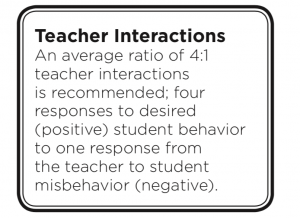General praise or commonly used phrases such as “good job,” though important for
a pleasant classroom, are inadequate for building and sustaining desired behavior. Students need clear, specific feedback on their use of the schoolwide expectations and any other behaviors such as acts of kindness, compassion, helpfulness, and general positive citizenship that are extended reflections of your expectations. Effective specific positive feedback: 1) specifically describes the behavior, 2) provides reasons or rationales, and 3) can include a positive consequence.
Hattie (2012) identifies feedback as an “essential ingredient” of learning. He goes on to say:
“The greater the challenge, the higher the probability that one seeks and needs feedback, but the more important it is that there is a teacher to provide feedback and to ensure that the learner if on the right path to successfully meet the challenges” (p. 17)
Specifically describe the behavior. Students need to know explicitly what behavior they did that was correct and earned the acknowledgement of the teacher. Teachers readily do this when giving feedback about academic work. Teachers often use a rubric when reviewing academic work that helps specifically describe the desirable behavior displayed. Davis (2007) describes this as acting “like a video camera, helping students see their own positive behavior.” In effective praise we simply describe the behavior observed to make the feedback clear and specific. For example, “When I said it was time to begin your assignment, you cleared off your desk, got your materials out immediately, and began working quickly.” It is a videotape replay of exactly what the student did, couched in the words of your expectations. Do not add any references to past mistakes the student has made or wishes for future behavior. Simply describe exactly what you saw that you want the student to continue doing in the future. Additionally, be cautious in adding “I’m proud of you.” We want students doing the appropriate behavior because of the benefits to them rather than simply to please the teacher.
Provide a rationale. Explain the reason why the behavior is important. Rationales or reasons teach the students the benefits of their behavior and the impact it has on them and others. This often includes stating the overarching schoolwide expectation (e.g., respect, caring, cooperation, etc.) and pointing out what the student might expect could happen if they use the appropriate behavior. “Getting started right away like that shows cooperation and will help you avoid having homework.”
Can include a tangible item or preferred activity. For many students, the specific positive feedback alone is sufficiently reinforcing to strengthen the behavior. However, for some students, and when a behavior requires a great deal of effort, pairing the verbal feedback with tangible or activity reinforcement may be helpful. When using a tangible item or preferred activity it is imperative that you also use the complete verbal praise so that students are aware of exactly what they did that has resulted in earning the consequence. It is not the consequence that changes the behavior so much as the awareness of what is being reinforced; the consequence merely provides additional incentive.
You will want to say something like, “Cherie, you gathered your group’s materials and returned them to the shelf; great example of responsibility. You have earned a Cardinal Card.” Note that adults do not “give,” instead students “earn.” Careful use of these terms helps students to take ownership for their behaviors and teaches the link between appropriate behavior and positive outcomes.
It is also important that specific positive feedback be given sincerely and appropriately for student’s age. This is especially important when working with older students. Staff need to find their own style to communicate sincere care and concern for the student. Use of a variety of phrases shows spontaneity and therefore credibility.
There are some considerations for when and how to use specific positive feedback. Use specific positive feedback:
Contingently. Since students “earn” specific positive feedback and consequences, it is provided only when they have demonstrated the desired behavior.
Immediately. Specific positive feedback is best when it follows closely to the behavior so that students can connect what they did with the feedback they are receiving. The younger the student, the more important this is.
Frequently when trying to build a new behavior. When students are learning new skills, provide feedback on a continuous schedule. This means that every time the student displays the desired behavior, they receive specific positive feedback.
 Unpredictably or Intermittently to maintain behavior. Once the skill or behavior has been learned, you can shift to use of general praise and occasional use of specific positive feedback. This intermittent use of specific positive feedback helps to maintain the behavior. We must be careful not to omit all specific positive feedback as students may not sustain the skills that they have learned.
Unpredictably or Intermittently to maintain behavior. Once the skill or behavior has been learned, you can shift to use of general praise and occasional use of specific positive feedback. This intermittent use of specific positive feedback helps to maintain the behavior. We must be careful not to omit all specific positive feedback as students may not sustain the skills that they have learned.
Benefits of Specific Positive Feedback
- Helps adults and students focus on positive social behaviors and actions.
- It is the most powerful behavior change tool teachers have in their repertoire.
- Increases the likelihood students will use the recognized behaviors and skills in the future.
- Decreases inappropriate behavior and therefore, reduces the need for correction.
- Enhances self-esteem and helps build internal locus of control (i.e., self-regulation).
This video from the Council for Exceptional Children’s resources on High Leverage Practices highlights the critical importance of providing feedback:
High Leverage Practices #8 and #22 – Provide Positive and Constructive Feedback to Guide Students’ Learning and Behavior https://highleveragepractices.org/701-2-3/

